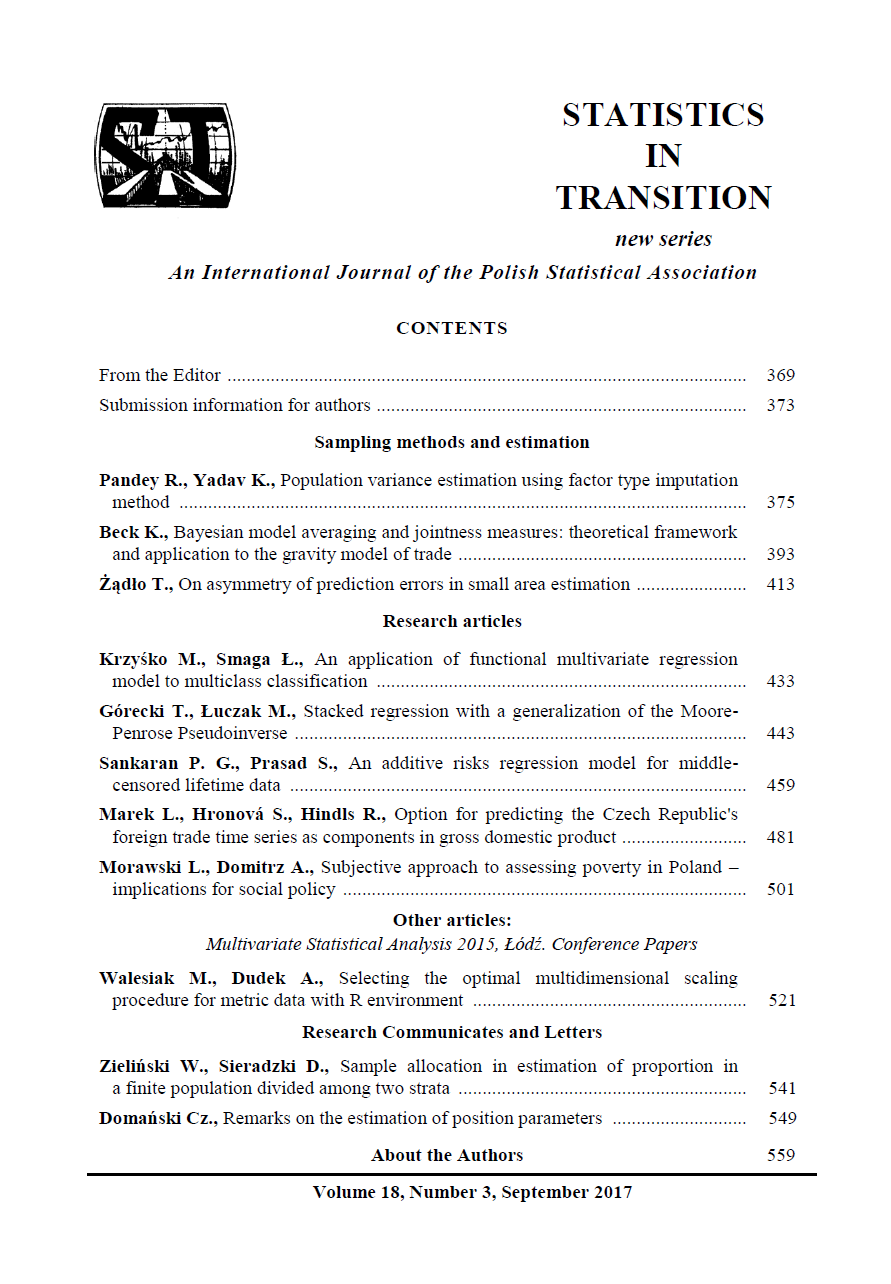ARTICLE
ABSTRACT
We propose a variance estimator based on factor type imputation in the presence of non-response. Properties of the proposed classes of estimators are studied and their optimality conditions are derived. The proposed classes of factor type ratio estimators are shown to be more efficient than some of the existing estimators, namely, the usual unbiased estimator of variance, ratio-type, dual to ratio type and ratio cum dual to ratio estimators. Their performances are assessed on the basis of relative efficiencies. Findings are illustrated based on a simulated and real data set.
KEYWORDS
auxiliary information, mean squared error, simple random sampling without replacement (SRSWOR).
REFERENCES
AGRAWAL, M. C., STHAPIT, A. B., (1995). Unbiased Ratio-Type Variance Estimation, Statistics and Probability Letters, 25, pp. 361–364.
ARCOS, A., RUEDA, M., MARTINEZ, M. D., GONZALEZ, S., ROMAN, Y., (2005). Incorporating the auxiliary information available in variance estimation, Applied Mathematics and Computation, 160, pp. 387–399.
BEAUMONT, J. F., HAZZIA, D., BOCCI, C., (2011). On variance estimation under auxiliary value imputation in sample surveys. Statistica Sinica, 21,pp. 515–537.
BEAUMONT, J. F., HAZIZA, D., BOCCI, C., (2011). On variance estimation under Auxiliary value imputation in sample surveys, Statistica Sinca, 21, pp. 515–537.
DAS, A. K., TRIPATHI, T. P., (1978). Use of auxiliary information in estimating the finite population variance, Sankhya, C, 40, pp. 139–148.
FAY, B. E., (1991). A design based pros, predictive on missing data variance. Proceedings of the annual Research Conference, U.S., Bureau of the census, pp. 429–440.
GARCIA, M. R., CEBRAIN, A. A., (1996). Repeated substitution method: The ratio estimator for the population variance, Metrika, 43, pp. 101–105.
ISAKI, C. T., (1983). Variance estimation using auxiliary information, Journal of the American Statistical Association, 78, pp. 117–123.
KADILAR, C., CINGI, H., (2006). Ratio estimators for the population variance in simple and stratified random sampling, Applied Mathematics and Computation, 173, pp. 1047–1059.
KADILAR, C., CINGI, H., (2006a). Improvement in Variance Estimation using Auxiliary Information, Hacettepe Journal of Mathematics and Statistics, 35 (1), pp. 111–115.
KIM, J. K., BRICK, J. M., FULLER, W. A., KALTON, G., (2001). On the bias of the multiple imputation variance estimator in survey sampling, Journal of the Royal Statistical Society series B, 68, pp. 509–521.
MURTHY, M. N., (1967). Sampling Theory and Methods. Statistical Publishing Society, Calcutta, India.
RAGHUNATH, A. AND SINGH, S. (2006). Estimation of variance from missing data, Metron-International Journal of Statistics, LXIV, 2, pp. 161–177.
RAO, SITTER, (1995). Variance estimation under two phase sampling with application to imputation for missing data. Biometrika, 82, pp. 453–460.
RAO, J.N.K. (1996). On variance estimation with imputed survey data. Journal of the American Statistical Association, 91 (434), pp. 499-506.
RAO, J. N. K., SHAO J., (1992). Jackknife variance estimation with survey data under hot deck imputation. Biometrika, 79 (4), 811–822.
REDDY, V. N., (1978). A Study on the use of Prior Knowledge on Certain Population Parameters in Estimation. Sankhya, C, 40, pp. 29–37.
RUBIN, D. B., (1976). Inference and missing data, Biometrika, 63(3), pp. 581–592.
SARANDAL, C. E., (1992). Methods for estimating the precision of survey estimates when imputation has been used, Survey Methodology, 18, pp. 241–252.
SHUKLA, D., THAKUR, N. S., (2008). Estimation of mean with imputation of missing data using factor-type estimator, Statistics in Transition, 9, 1, pp. 33–48.
SINGH, H. P., UPADHYAYA, L. N., NAMJOSHI, U. D., (1988). Estimation of finite population variance, Current Science, 57, pp. 1331–1334.
SINGH, H. P., KATYAR, N. P., (1991). Variance estimation through the mean square successive differences and sample variance using a priori information, Journal of the Indian Society of Agricultural Statistics, 43, 1, pp. 16–29.
SINGH, H. P., SOLANKI, R. S., (2009). Estimation of finite population variance using auxiliary information in presence of random non-response, Gujarat Statistical Review, 1, pp. 37–637.
SINGH, H. P., SOLANKI, R. S., (2010). Estimation of finite population variance using auxiliary information in presence of random non-response, Gujarat Statistical Review, 2, pp. 46–58.
SINGH, V. K., SHUKLA, D., (1987). One parameter family of factor-type ratio estimator, Metron, 45, 1-2, pp. 273–283.
SOLANKI, R. S., SINGH, H. P., (2013). An improved class of estimators for the population variance, Model Assisted Statistics and Applications 8, 3, pp. 229–238.
SRIVENKATRAMANA, T., TRACY, D. S., (1980). An alternative to ratio method in sample surveys, Annals of the Institute of Statistical Mathematics, 32, pp. 111–120.
YADAV, S. K., KADILAR, C., (2013). Improved exponential type ratio estimator of population variance, Revista colombiana de Estadistica, 36, 1, pp. 145–152
